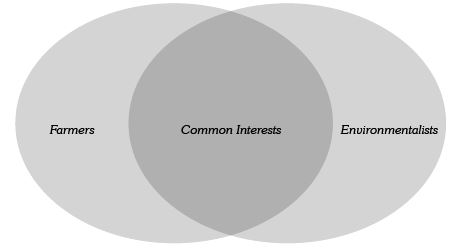Caring for the Land
Students explain why people have different opinions regarding soil management and identify cause and effect relationships relating to agriculture and the environment.
Background
Lesson Activities
Recommended Companion Resources
Credits
Author
Debra Spielmaker | Utah Agriculture in the Classroom
Acknowledgements
Lesson adapted from materials provided by Oklahoma Agriculture in the Classroom.
Standards
Indiana Content Area Standards
-
English Language Arts.Grade 3.RN.1
Read and comprehend a variety of nonfiction within a range of complexity appropriate for grades 2-3. By the end of grade 3, students interact with texts proficiently and independently.
- Connection of Ideas.3.RN.4.1: Distinguish between fact and opinion; explain how an author uses reasons and facts to support specific points in a text.
- Key Ideas and Textual Support.3.RN.2.1: Ask and answer questions to demonstrate understanding of a text, referring explicitly to the text as the basis for the answers.
- Structural Elements and Organization.3.RN.3.2: Identify how a nonfiction text can be structured to indicate a problem and solution or to put events in chronological order.
-
English Language Arts.Grade 3.RV.1
Build and use accurately conversational, general academic, and content-specific words and phrases.
- Vocabulary in Literature and Nonfiction Texts.3.RV.3.2: Determine the meanings of general academic and content-specific words and phrases in a nonfiction text relevant to a third grade topic or subject area.
-
English Language Arts.Grade 3.SL.1
Listen actively and adjust the use of spoken language (e.g., conventions, style, vocabulary) to communicate effectively with a variety of audiences and for different purposes.
- Comprehension.3.SL.3.2: Ask and answer questions about information from a speaker, offering appropriate elaboration and detail.
- Discussion and Collaboration.3.SL.2.1: Engage effectively in a range of collaborative discussions (one-on-one, in groups, and teacher-led) on grade- appropriate topics and texts, building on others ideas and expressing personal ideas clearly.
- Discussion and Collaboration.3.SL.2.2: Explore ideas under discussion by drawing on readings and other information.
-
English Language Arts.Grade 4.RN.1
Read and comprehend a variety of nonfiction within a range of complexity appropriate for grades 4-5. By the end of grade 4, students interact with texts proficiently and independently at the low end of the range and with scaffolding as needed at the high end.
- Connection of Ideas.4.RN.4.1: Distinguish between fact and opinion; explain how an author uses reasons and evidence to support a statement or position (claim) in a text.
- Key Ideas and Textual Support.4.RN.2.1: Refer to details and examples in a text when explaining what a text says explicitly and when drawing inferences from the text.
- Key Ideas and Textual Support.4.RN.2.3: Explain the relationships between events, procedures, ideas, or concepts in a historical, scientific, or technical text based on specific information in the text.
-
English Language Arts.Grade 4.RV.1
Build and use accurately general academic and content-specific words and phrases.
- Vocabulary in Literature and Nonfiction Texts.4.RV.3.2: Determine the meanings of general academic and content-specific words and phrases in a nonfiction text relevant to a fourth grade topic or subject area.
-
English Language Arts.Grade 4.SL.1
Listen actively and adjust the use of spoken language (e.g., conventions, style, vocabulary) to communicate effectively with a variety of audiences and for different purposes.
- Discussion and Collaboration.4.SL.2.1: Engage effectively in a range of collaborative discussions (one-on-one, in groups, and teacher-led) on grade- appropriate topics and texts, building on others ideas and expressing personal ideas clearly.
- Discussion and Collaboration.4.SL.2.2: Explore ideas under discussion by drawing on readings and other information.
- Discussion and Collaboration.4.SL.2.4: Pose and respond to specific questions to clarify or follow up on information, and make comments that contribute to the discussion and link to the remarks of others.
-
English Language Arts.Grade 5.RN.1
Read and comprehend a variety of nonfiction within a range of complexity appropriate for grades 4-5. By the end of grade 5, students interact with texts proficiently and independently.
- Connection of Ideas.5.RN.4.1 : Explain how an author uses reasons and evidence to support claims in a text, identifying which reasons and evidence support which claims.
- Key Ideas and Textual Support.5.RN.2.2: Determine two or more main ideas of a text and explain how they are supported by key details; summarize the text.
-
English Language Arts.Grade 5.RV.1
Build and use accurately general academic and content-specific words and phrases.
- Vocabulary in Literature and Nonfiction Texts.5.RV.3.2: Determine the meaning of general academic and content-specific words and phrases in a nonfiction text relevant to a fifth grade topic or text.
-
English Language Arts.Grade 5.SL.1
Listen actively and adjust the use of spoken language (e.g., conventions, style, vocabulary) to communicate effectively with a variety of audiences and for different purposes.
- Discussion and Collaboration.5.SL.2.1: Engage effectively in a range of collaborative discussions (one-on-one, in groups, and teacher-led) on grade- appropriate topics and texts, building on others ideas and expressing personal ideas clearly.
- Discussion and Collaboration.5.SL.2.4: Pose and respond to specific questions by making comments that contribute to the discussion and elaborate on the remarks of others.
- Discussion and Collaboration.5.SL.2.5: Review the key ideas expressed and draw conclusions in reference to information and knowledge gained from the discussions.
